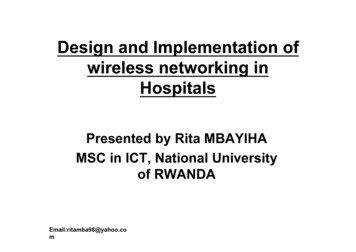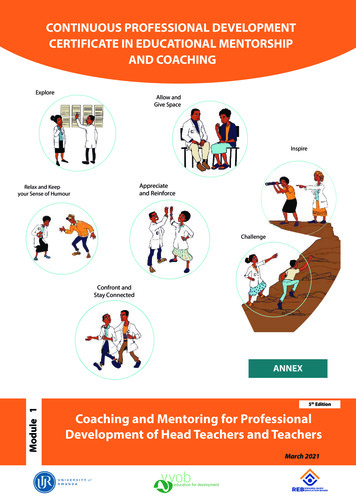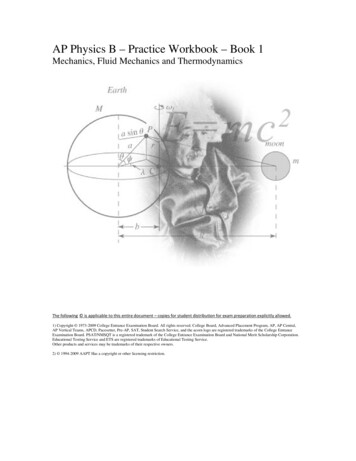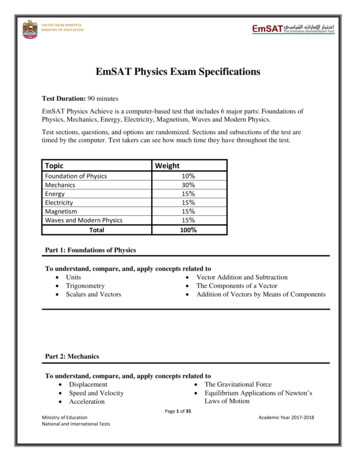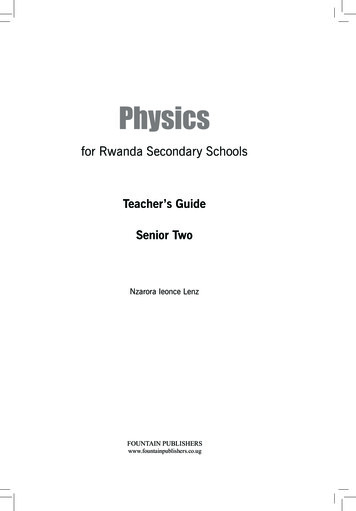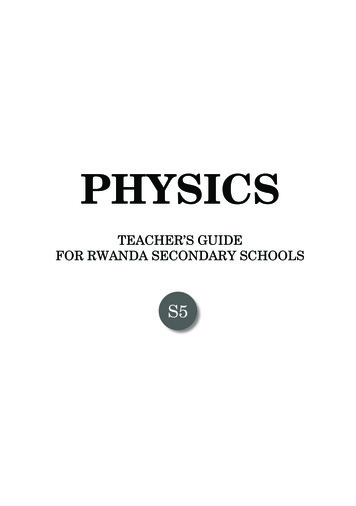
Transcription
PHYSICSTEACHER’S GUIDEFOR RWANDA SECONDARY SCHOOLSS5
CONTENTSIntroduction. ii - liv1. Wave and Practical Nature of Light. 1-221.1 Unit description. 11.2 Lesson development . 41.3 Main contents and concepts to emphasise. 141.4 Solution to Activities and Exercises. 162. Simple Harmonic Motion. 23-471.1 Unit description. 231.2 Lesson development . 261.3 Main contents and concepts to emphasise. 331.4 Solution to Activities and Exercises. 353. Forced Oscillations and Resonance of a System. 48-611.1 Unit description. 481.2 Lesson development . 511.3 Main contents and concepts to emphasise. 604. Propagation of Mechanical Waves. 62-771.1 Unit description. 621.2 Lesson development . 651.3 Main contents and concepts to emphasise. 741.4 Solution to Activities and Exercises. 755. Complex Electrical Circuit. 78-95ii
1.1 Unit description. 781.2 Lesson development . 801.3 Main contents and concepts to emphasise. 911.4 Solution to Activities and Exercises. 926. Fossil and Non-fossil Fuel and Power Production. 96-1111.1 Unit description. 961.2 Lesson development . 991.3 Main contents and concepts to emphasise. 1107. Electric field potential and gravitational potential. 112-1271.1 Unit description. 1221.2 Lesson development . 1151.3 Main contents and concepts to emphasise. 1241.4 Solution to Activities and Exercises. 1278. Motion in Orbits. 128-1451.1 Unit description. 1281.2 Lesson development . 1311.3 Main contents and concepts to emphasise. 1401.4 Solution to Activities and Exercises. 1439. Atomic models and photoelectric effect. 146-1651.1 Unit description. 1461.2 Lesson development . 1491.3 Main contents and concepts to emphasise. 1581.4 Solution to Activities and Exercises. 161iii
10. Analog and Digital Signals. 166-1831.1 Unit description. 1661.2 Lesson development . 1691.3 Main contents and concepts to emphasise. 1791.4 Solution to Activities and Exercises. 18211. Mobile phone and radio communication. 184-1961.1 Unit description. 1841.2 Lesson development . 1681.3 Main contents and concepts to emphasise. 19512. Relativity concepts and postulates of special relativity. 197-2101.1 Unit description. 1971.2 Lesson development . 2001.3 Main contents and concepts to emphasise. 2081.4 Solution to Activities and Exercises. 20913. Interference of Light Waves. 211-2251.1 Unit description. 2111.2 Lesson development . 2141.3 Main contents and concepts to emphasise. 22214. Stellar Distance and Radiation. 226-2401.1 Unit description. 2261.2 Lesson development . 2281.3 Main contents and concepts to emphasise. 2381.4 Answers to end of unit questions. 239iv
IntroductionPHYSICS AND SOCIETYThe purpose of this teacher guide is to help teachers to implement thePhysics syllabus of senior five according to unit planning, lesson planningand lesson delivery to develop the learners’ competences and skills. It isdesigned to stimulate teachers to create meaningful teaching programs andlessons by enabling them to choose relevant and purposeful activities andteaching activities. It will encourage teachers to research and look for newand challenging ways of fecilitating students’ learning in Physics.The teacher guide supports the syllabus. The syllabus states the key unitcompetences to develop, links to other subjects, assessment criteria, learning outcomes for the subject and units, and outlines the content and skillsthat students will learn.Rationale of teaching and learning physicsPHYSICS AND SOCIETYPhysics is one of the natural science subjects and contributes significantlyto global socioeconomic transformation through its discoveries. These haveled to development of new technologies in all fields of production and arebeneficial to mankind. Applications of Physics knowledge is evident inindustries, engineering, transportation (automobiles, trains, flights etc),medicine and Information and Communication Technology (ICT).Physics significantly contributes to the advancement of new technologiesthat arise from theoretical breakthroughs. For example, advances andunderstanding of electromagnetism or nuclear physics has led to thedevelopment of new products which have dramatically transformed themodern society. Some of the discoveries based on Physics knowledgeinclude televisions, computers, electrical appliances, nuclear weapons,advancements in thermodynamics and mechanics which have led to massindustrialization.Physics is the key to the Rwandan education ambition of developing aknowledge-based society since it promotes science and technology whichare necessary for learners to be competent both at regional and global jobv
markets. This new curriculum will address gaps in the current RwandaEducation system which lacks of appropriate skills and attitudes providedby the current education system.PHYSICS AND LEARNERSPhysics is a worthwhile subject because it prepares students for the realworld of work by providing career pathways in mechanical and constructionengineering, information and communication technology and other relatedfields. Physics provides skills that guide the construction of theories andlaws that help to explain natural phenomena and enable management ofenvironment.It also provides answers to problems modern society by empoweringstudents, make them to be creative and innovative, leading to independentapproaches of solving daily life problems. Through physics, students explorethe laws and rules that govern all the natural phenomena associated withthe subject observed in the universe.Methods, Strategies, Attitudes and TechniquesThis section addresses the methods, strategies, attitudes and techniquesrecommended in the program. While they are different from the concepts,these elements are important in the development of competencies.METHODSMethods require special attention. They should not be applied in isolation,but in learning and evaluation situations in which several of them arecombined. The ability to apply a combination of different methods is anindicator of proficiency.Five methods are presented here: modeling, observation, analysis,experimentation and the empirical methods.MODELINGModeling consists in constructing a representation of an abstract situation,one that is difficult to observe or impossible to see. This representationcan be a text, a drawing, a mathematical formula, a chemical equation,a software program or a scale model. Over time, the model becomes morerefined and complex. It may be valid only for a certain amount of time andin a specific context and in many cases, it can be modified or rejected. Itvi
is also important to consider the context in which it was created. A modelmust help learners understand a given reality, explain certain properties ofthat reality and predict new observable phenomena.OBSERVATION METHODThe observation method is an active process intended to help the observer/learner interpret facts on the basis of his or her predetermined criteria andgenerally accepted criteria within a given field. In light of the informationcollected, learners gain a new understanding of the facts, which isinextricably linked to the context in which the observations were made.In his or her interpretation and organization of information, the learnerreinterprets the physical world on the basis of his or her assumptions andthe conceptual schemes that are an integral part of what he or she bringsto the observation process. All observations involve a theoretical modelestablished by the observer.ANALYSISThe elements that determine or make up a phenomenon, an object or asystem, as well as the interactions between these elements, can be identifiedthrough analysis. Analysis also leads to the identification of structuraland functional components, which can in turn be analyzed, and to thedetermination of their hierarchical or interdependent connections. In somecases, this method involves using a broader understanding of a system todetermine the function of its parts and the relationships between them,thereby making it possible to highlight the dynamics of a complex systemand examine its behaviour over time. This aspect of the analytical methodis particularly useful in studying phenomena and applications.EXPERIMENTAL METHODThe experimental method begins with the formulation of preliminaryexplanations. Then learners can begin looking for an answer and definingthe framework of the experiment. It then becomes necessary to developan experimental procedure in order to identify a certain number ofvariables to be manipulated. The aim of the procedure is to identify andcompare observable or quantifiable elements and check them against theinitial hypotheses. Moving back and forth between the different stagesof the experimental method raises new questions and allows students tovii
formulate new hypotheses, adjust the experimental procedure and take thelimitations of the experiment into account.EMPIRICAL METHODThe empirical method involves field research without any manipulation ofvariables. Its spontaneity does not detract from the methodology involved(for example, a sample survey is an empirical approach that leaves nothingto chance). Often based on intuitive models, this method sometimes providesa way of exploring and representing the elements of a problem. Often, it canlead to a number of preliminary ideas, hypotheses and theories, as well asnew techniques and possible avenues for other research projects.Source: Québec Education Program - PhysicsThe role of the teacherTeachers play a fundamental role in helping their students developcompetencies. The support they provide must relate to the three aspectsof every competency: the mobilization of resources in a specific context, theavailability of resources and the ability to reflect on the process involved.Teachers must offer learning and evaluation situations that promote thedevelopment of the target competencies, support the students’ learningprogress and evaluate their level of competency development.The role of learnersAlthough the teacher sets the pedagogical framework, it is important for thestudents to be fully engaged in the learning process. Only they can makethe necessary connections between their previous knowledge and the newconcepts they must assimilate, and they must also adapt their knowledgeto the concepts to be learned, and vice versa.It is important for students to use appropriate techniques when handlingequipment and substances. If they use verification or control instruments,they must take into account possible errors in their measurements, whethercaused by the instrument, the user or the environment. They must recordtheir measurements using an appropriate number of significant figures andanalyze their results based on a certain margin of error. At all times, theymust comply with safety standards and handle equipment and substanceswith care. When in doubt, they must ask the teacher or laboratoryviii
technician to ensure that they are working safely and using the equipmentand substances correctly.Learning OutcomesExpected outcomes are summarized in table I.Table I: Learning outcomesLearningVery highVery nsiveDemonstratessoundknowledge1. Demonstrateunderstanding offundamental physicsprinciplesand modelsknowledgeand understands awide rangeof physicsprinciplesand models2. ApplyHighlyscientificcreativeinquiry and and innoreasoningvative inskills toconductingfind soluinvestigations totions usingproblemsscientificmethodologies to findsolutions toproblems3. Communicatescientificdata andinformationHighly efficient andinnovativein tration ofknowledgeof physicsprinciplesand modelsand understandingof physicsprinciplesand modelsSoundinquiry andreasoningskills inconductinginvestigations usingscientificmethodologies infindingsolutions toproblemsVery goodin communicatingscientificdata andAdequateinquiry andreasoningskills withfair idea ofusing scientific methodologiesin findingsolutions toproblemsAdequatecompetencyin itedknowledgeof physicsprinciplesand modelsHas failedto demonstrateunderstanding offundamental physicsprinciplesand modelsDemonstrates limited inquiryand reasoning skillsin problemsolvingusing scientific methodologiesHas failedto demonstratescientificinquiry andreasoningskills insolvingproblemsusing scientific methodologiesLimitedcompetencyin communicatinginformation informationixBelowminimumHas failedtoachievecompetencyin
from investigationsand laboratory workin differentwaysinformationand scientific datafrom investigationsand laboratory workinformationfrom investigationsand laboratory work4. AnalyseandExcellentanalysisinterpretdata andand interpretationVery goodin analysing andinformation of data andand scientific datafrominvestigations andlaboratoryworkand scientific datafrom investigationsand laboratory ta- ability inanalysingtionand interof data andpretinginformationdata andinterpreting datainformation and informationcommunicatinginformationand scientific datafrom investigationsand laboratory workHas failedto demonstrateability toanalyse andinterpretdata andinformationinformation5. Analyseand evaluate developments isionsbasedbased onphysicsfrom theon excellent on soundanalysisanalysisanalysisandpast andpresent andits impacton peopleand theenvironment; anduse theinformationto supportand makeinformedandevaluationofdevelopments indecisionsadequateand evalua- evaluationtion ofofdevelopdevelopments inmentsphysics and in physicsphysics and theirandtheirimpact ontheir imsocietyimpact onpact onsocietysocietydecisionsxMakes deci- Makes decisionssionsbased onlimitedbased ofdevelopments indevelopments inphysics and physics andtheirtheir impact onsocietyimpact onsociety
6. RelaterelevantDisplaysexcellenttraditionalability dge, beliefconcepts ofphysics.knowledge,beliefs,and skillsto principles andconcepts ofphysicsCan effectively perceive relateknowledge,belieftraditionaland skillstobelief andskills toprinciplesprinciplesandknowledge,concepts ofand conceptsphysicsof physicsShows limited abilityin perceiving andIs not ableto dge,beliefknowledge,correlatebelief andskills toprinciplesandand skillstoconcepts ofconcepts ofphysicsphysicsprinciplesandSource: physics upper secondary education teacher guide, Department ofEducation, Papua New Guinea. ISBN 978-9980-9925-4-3Knowledge and UnderstandingWhen preparing and teaching physics, the teacher should think andpinpoint some requirements to meet some expected outcomes. Students areexpected to: understand phenomena, facts and patterns, principles, concepts, laws,theories and models in physics; learn vocabulary, terminology and conventions in physics; acquire knowledge of techniques and skills specific to the study ofphysics; group and organise physical knowledge and understanding, and applythem to familiar and unfamiliar situations; and develop an understanding of technological applications of physics andof their social implications.Skills and ProcessesPhysics teachers must strive to provide opportunities for students to developlife skills. Student activities are designed to address the content knowledgethat general science strands usually ignore. There are many skills studentsdevelop through interactive science. So students are expected to: develop scientific thinking and problem-solving skills;xi
acquire an analytical mind to critically evaluate physics-relatedissues; communicate scientific ideas and values in meaningful and creativeways with appropriate use of diagrams, symbols, formulae, equationsand conventions, as well as verbal means; acquire practical skills such as how to manipulate apparatus andequipment, carry out given procedures, analyse and present data,draw conclusions and evaluate experimental procedures; make careful observations, ask relevant questions, identify problemsand formulate hypotheses for investigation; plan and conduct scientific investigations individually or collaborativelywith appropriate instruments and methods, collect quantitativeand qualitative data with accuracy, analyse and present data, drawconclusions and evaluate evidence and procedures; develop study skills to improve the effectiveness and efficiency oflearning; and develop abilities and habits that are essential to lifelong learningValues and AttitudesStudents are expected to: develop positive values and attitudes such as curiosity, honesty, respectfor evidence, perseverance and tolerance of uncertainty through thestudy of physics; develop a habit of self-reflection and the ability to think critically; be willing to communicate and comment on issues related to physics,and demonstrate an open-mindedness towards the views of others; be aware of the importance of safety for themselves and others, and becommitted to safe practices in their daily life; appreciate the achievements made in physics and recognise theirlimitations; be aware of the social, economic, environmental and technologicalimplications of achievements in physics; and recognise the importance of life-long learning in our rapidly changingknowledge-based society.Competences to developxii
INTEGRATION OF COMPETENCESA competence-based curriculum takes learning to higher levels by providingChallenging and engaging learning experiences which require deep thinkingrather than just memorisation. Its focus is on what young people can dorather than just on what they know.There are two categories of competences in a competence-based curriculum:Basic competences and generic competences.Basic CompetencesBasic competences are main, key or vital competences identified basing onexpectations and aspirations reflected in the national policy documents.It is on the basis of descriptors of these competences that are built intothe learners profile in each level of education, subjects to be taught andlearning areas.Basic competences are listed in the diagram below Literacy Numeracy ICT Citizenship and National Identity Entrepreneurship and Business Development Science and Technology Communication in the official languagesThese have all been identified as competences with particular relevance toRwanda on account of its history and context.Literacy and numeracy are basic to accessing learning in other subjects.Competence in ICT can be developed through the use of ICT across thesubjects. One of the nation’s great strengths is its unity in terms of both itspopulation and its sense of purpose. The focus on citizenship and nationalidentity is important in this respect.There is a key drive to ensure that Rwandans actively create employmentopportunities rather than having a mindset of relying on others. Henceentrepreneurship and business development is regarded as basic.The impact of science and technology increasingly affects all aspects of lifeand therefore should be considered a basic aspect of subjects across thexiii
curriculum.Generic CompetencesGeneric competences involve and promote the development of the higherorder thinking skills. In doing so they boost subject learning as well asbeing highly valuable in themselves. They are seen as generic competencesbecause they apply across all curricula, and can be developed in all thesubjects studied.Developing competencesCompetences cannot be taught directly like subject knowledge. They areacquired over time through the cumulative effect of a competence approachto learning. They require students to practice and employ the genericcompetences throughout the subjects that they study. They require teachersto adopt approaches that encourage and enable students to think critically,to carry out research, to solve problems, to be creative and innovative, tocommunicate, to co-operate and to become life-long leaners.The subject content provides a necessary context for students to develop thecompetences, and the basic and generic competences help deepen students’understanding of the subject and build students’ ability to apply theirsubject learningGeneric CompetencesThe generic student competences that will be developed within all subjectsare: Critical thinking Creativity and innovation Research and problem solving Communication Co-operation, interpersonal relations and life skills Life long learningThese generic competences help students deepen their understanding ofsubjects and apply their subject learning in a range of situations. Theytherefore contribute to the development of subject competence.xiv
As students develop these generic competences they also acquire the set ofskills that employers look for in their employees, so the competences helpprepare students for the world of work.The generic competences are also vital for enabling students to become lifelong learners who can adapt to our fast-changing world and the uncertainfuture. Competence in a subject requires a learner to have achieved anappropriate level in terms of all two categories of competence.Higher Order Thinking Skills (HOTS)Higher Order Thinking Skills (HOTS) are central to a competence-basedcurriculum because they develop the understanding that enables learningto be applied effectively.As the table below shows, Knowledge and Understanding learning objectivesrelate to memorisation and explanation -the lower levels of learning. Skillslearning objectives use more challenging, active verbs so that learners arerequired to think more deeply and to develop higher order thinking skills.It is important to highlight the fact that knowledge and understanding areno lessimportant in a competence-based curriculum. High levels of knowledgeand understanding are crucial for a successful knowledge-based economy.It is through the focus on competences and higher order thinking skillsin a competence-based curriculum that learners’ skills and abilities aredeveloped and, as a consequence, their knowledge and understanding aredeepened.There must be opportunities in subjects for students to develop and to applybasic skills and cross cutting issues where possible. Subject syllabi mustfocus on what learners need to be able to do as well as on subject knowledge.Basic competences are developed through application of subject learning.The generic competences help the development of the higher order thinkingskills so both will deepen subject learning and be valuable in themselves.xv
AssessmentCompetence based assessment is an assessment process in which thelearner is confronted with a complex situation related to their everydaylife and asked to put into practice what has been learned(knowledge, skillsand attitude) in order to resolve or overcome this situation. In competencebased assessment the evidence collected is then used as the basis onwhich judgments are made concerning the learner’s progress towards thesatisfaction of fixed performance criteria.Assessment is an integral part of the teaching learning process. One of themajor purposes of assessment is to measure the extent to which learningobjectives and competences have been achieved and to identify whichschools and learners need pedagogical advice and strategic intervention.CoherenceIt is essential that the assessment measures are coherent across ages andschools so that learners can be confident that the standards being applied totheir work are compatible with standards across the country. To achieve thislevel of confidence in the design on the assessment the marking or gradingmust be trustworthy, delivering reliable and valid tests and examinations.Recognition of achievementAssessments must examine or measure what learners know and can do,and how far they succeed, avoiding focusing on what they are unable to do.Assessments must allow for learners to show their knowledge and skill inappropriate ways which may vary with learner, topic and competency.Accessible, equitable and fairAssessments must offer equal opportunities to learners to succeed, and beadaptable to learners’ circumstances. Assessments must be accessible toall learners in terms of the forms of questioning and testing. Accessibilityinvolves particular attention to the language demands for learners,especially those for whom English is an additional language.Support progressionAssessments should yield information about aspects of learners’ performancewhich can then be used to diagnose strengths and weaknesses, and nextsteps for learners.xvi
Formative assessments which are relevant to the current learningshould provide evidence which teachers can use to feedback to learners.Competencies, which include knowledge, skills and attitudes, should beassessed in the context of practical application in order for progress to beidentified and supported.Fit for purposeThe methods and forms of assessment should vary, according to such factorsas the domains being assessed, the age of the learners, the language inwhich the assessment is made. The use of the results of assessments affectsthe forms used, in both formal and informal contextsValidAny assessment must assess what it sets out to measure and be clearabout what is being assessed, including such aspects as memory, processes,application. In order to be valid the forms of assessment vary with what isbeing assessed.ReliableFormal assessments and examinations must be consistent in the resultsthey produce over time and for all learners. In examinations, as far aspossible, sources of inconsistency, such as item production, marking andlinguistic barriers must be eliminated.Transparent and accountableLearners, teachers and parents must understand the purposes, forms anduses of assessments that schools make. Schools should make the resultsof assessments available to learners and parents. Stakeholders and policymakers should take into account the results of assessments nationally whenmaking decisions.Types of AssessmentFormative assessment (Continuous assessment)Formative assessment is a crucial element of teaching and learning. Thegoal of formative assessment is to monitor student learning to provideongoing feedback that teachers can use to improve their teaching and bystudents to improve their learning.xvii
Physics is the key to the Rwandan education ambition of developing a knowledge-based society since it promotes science and technology which are necessary for learners to be competent both at regional and global job Introduction. vi markets. Th



